
- Android采取ContentObserver方式自动获取验证码
- Android实现抽奖转盘实例代码
- Android防止按钮过快点击造成多次事件的解决方法
- Handler与Android多线程详解
- Android中XUtils3框架使用方法详解(一)
- Android拍照或从图库选择图片并裁剪
- Android 再按一次返回键退出程序实现思路
- 基于Android代码实现常用布局
- Android笔记之:App列表之下拉刷新的使用
- Android中fragment嵌套fragment问题解决方法
- Android提高之Android手机与BLE终端通信
- Android中将View的内容保存为图像的简单实例
- Android中Webview打开网页的同时发送HTTP头信息方法
- Android ViewFlipper用法实例分析
- Android程序开发中单选按钮(RadioGroup)的使用详解
- Android UI设计系列之自定义SwitchButton开关实现类似IOS中UISwitch的动画效果(2)
- 解析:android 如何从JPEG生成BufferedImage
- android获取相册图片和路径的实现方法
- Android 监听Notification 被清除实例代码
- Android App在ViewPager中使用Fragment的实例讲解
- android 屏幕亮度调节方法详解
- Android植物大战僵尸小游戏
- Android自定义View之酷炫圆环(二)
- android 开发教程之日历项目实践(一)
- Android源码中final关键字的用法及final,finally,finalize的区别
- Android编程读取sd卡中图片的方法
- Android手机闹钟服务AlarmManagerk开发案例
- Android客户端软件开发_18、下载模块的菜单实现
- Android中实现下载和解压zip文件功能代码分享
- Android获取常用辅助方法(获取屏幕高度、宽度、密度、通知栏高度、截图)
android 自定义ScrollView实现背景图片伸缩的实现代码及思路
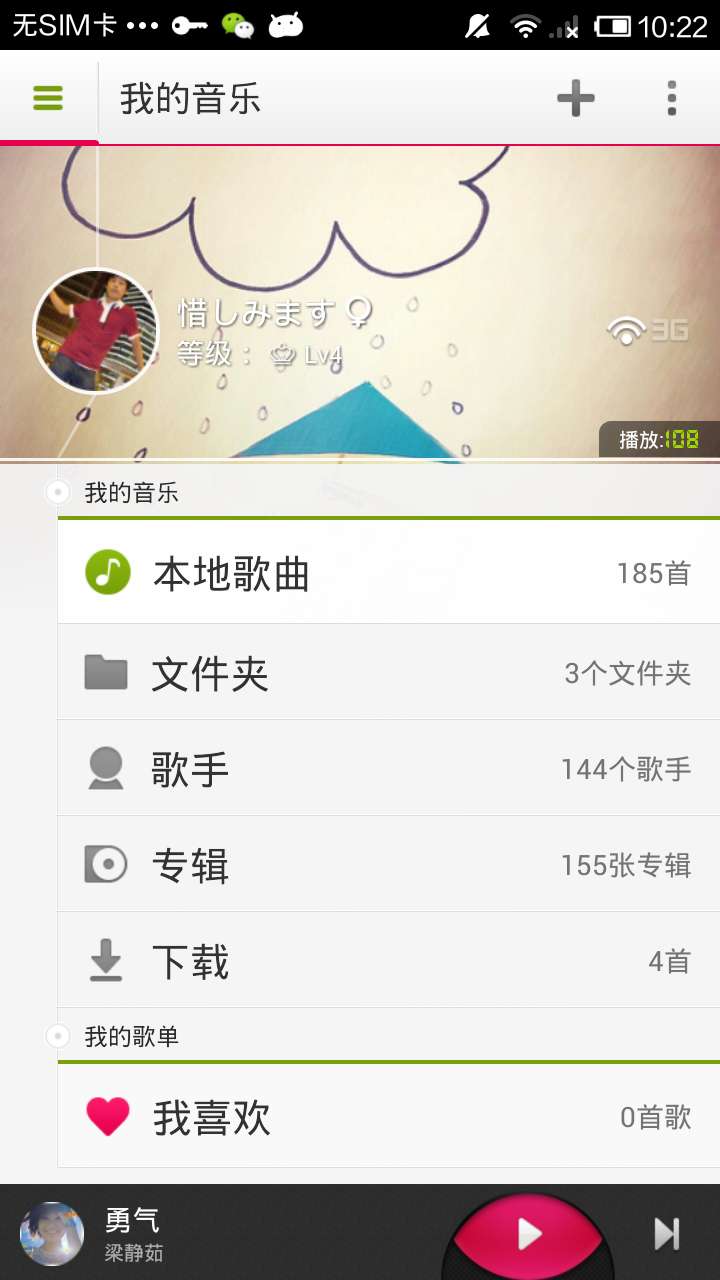
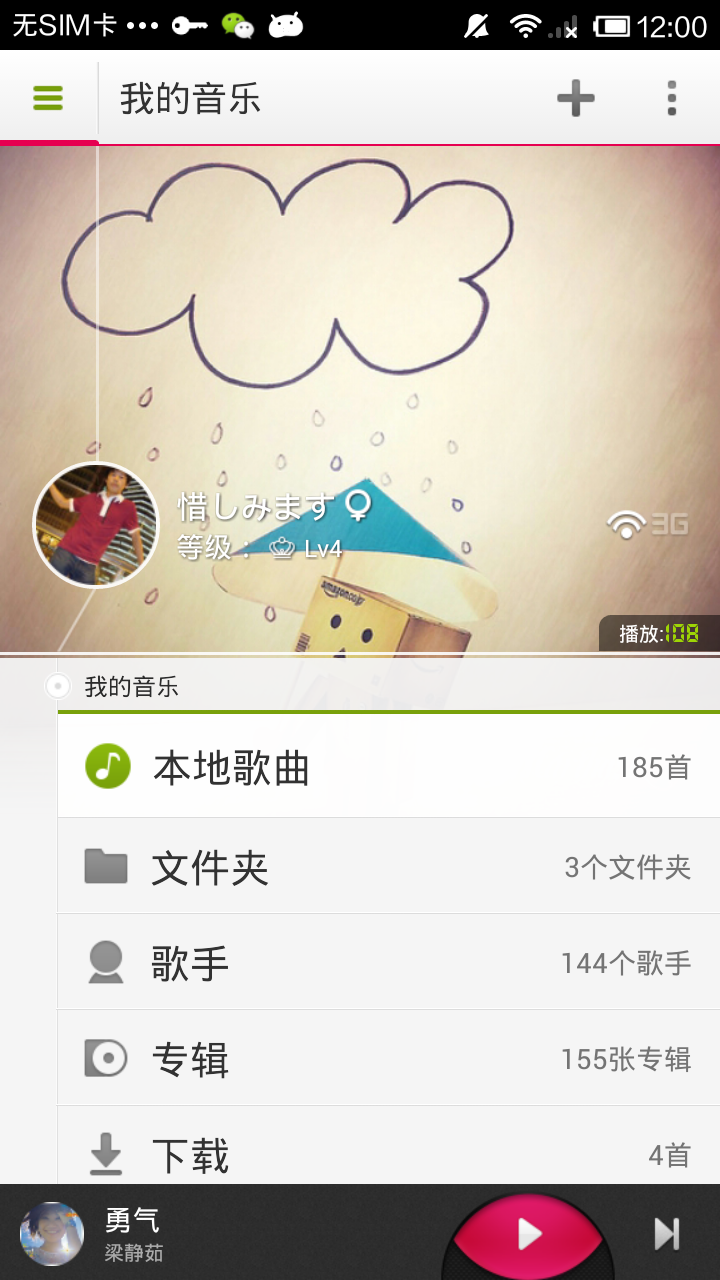
用过多米音乐的都市知道, 这个UI可以上下滑动,作用嘛---无聊中可以划划解解闷,这被锤子公司老罗称谓为“情怀”,其实叫“情味”更合适。嘿嘿.如今挪动互联网开展这么迅速,市场上已不再是那早期随便敲个APP放上架就能具有几十万用户的阶段了.近来苹果公司,为了怕android下载量赶超苹果商店,大势宣称:(第 500 亿个下载应用的用户就能够获得 10,000 美元的 iTunes 礼品卡,除此之外,紧随第 500 亿以后的前 50 名用户也可以获得 500 美元的礼品卡.至于挪动开展趋势,我想搞挪动IT的人心里都比拟清楚,扯远了).其实应用UI殊效是应用中很大的一部分,如果同样功能的两款软件,一个功能好点如“网易新闻”,另外一个略微差点如“新浪新闻”,用户的你毫无疑难确定会选择网易客户端.总结就是“操作性”对于产品起着至关重要的因素.
接下来我们看下如何实现,首先声明,这个实现的方式不是很好,我这里只是提出一个解决方案,大家可以根据自己的想法进行创新.
道理:RelativeLayout+自定义ScrollView.
我们大致看下布局结构如图:
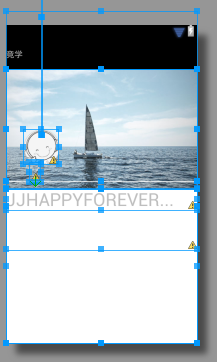

其实也没什么技术含量,我简单介绍下:红色代表的是背景照片,绿色的代表自定义ScrollView,粉色是代表你要编辑的透明区域.也不过多解释,想必大家都明确,我们还是来看代码吧。
由于属于情怀殊效(没有具体的回调事件要求),那么就没有必要自定义监听,回调处理,我直接把要处理的UI注入到自定义控件中,这样她方便我也方便.
在此说明一下,前面部分实现中有误,但是也希望您仔细品读,相信您必定可以学到一些知识的。
首先我们将背景图片和顶部线条注入到该控件中。接着我们看onTouchEvent事件,因为至始至终都是她在起作用.
复制代码 代码如下:
/***
* 触摸事件
*
* @param ev
*/
public void commOnTouchEvent(MotionEvent ev) {
int action = ev.getAction();
switch (action) {
case MotionEvent.ACTION_DOWN:
initTouchY = ev.getY();
current_Top = initTop = imageView.getTop();
current_Bottom = initBottom = imageView.getBottom();
lineUp_current_Top = line_up_top = line_up.getTop();
lineUp_current_Bottom = line_up_bottom = line_up.getBottom();
break;
case MotionEvent.ACTION_UP:
/** 回缩动画 **/
if (isNeedAnimation()) {
animation();
}
isMoveing = false;
touchY = 0;// 手指松开要归0.
break;
/***
* 消除出第一次挪动计算,因为第一次无法得知deltaY的高度, 然而我们也要进行初始化,就是第一次挪动的时候让滑动距离归0.
* 以后记载精确了就正常执行.
*/
case MotionEvent.ACTION_MOVE:
Log.e(TAG, "isMoveing=" + isMoveing);
touchY = ev.getY();
float deltaY = touchY - initTouchY;// 滑动距离
Log.e(TAG, "deltaY=" + deltaY);
/** 过滤: **/
if (deltaY < 0 && inner.getTop() <= 0) {
return;
}
// 当滚动到最上或者最下时就不会再滚动,这时挪动布局
isNeedMove();
if (isMoveing) {
// 初始化头部矩形
if (normal.isEmpty()) {
// 保存正常的布局位置
normal.set(inner.getLeft(), inner.getTop(),
inner.getRight(), inner.getBottom());
}
// 挪动布局(手势挪动的1/3)
float inner_move_H = deltaY / 5;
inner.layout(normal.left, (int) (normal.top + inner_move_H),
normal.right, (int) (normal.bottom + inner_move_H));
/** image_bg **/
float image_move_H = deltaY / 10;
current_Top = (int) (initTop + image_move_H);
current_Bottom = (int) (initBottom + image_move_H);
imageView.layout(imageView.getLeft(), current_Top,
imageView.getRight(), current_Bottom);
/** line_up **/
float line_up_H = inner_move_H;
lineUp_current_Top = (int) (line_up_top + inner_move_H);
lineUp_current_Bottom = (int) (line_up_bottom + inner_move_H);
line_up.layout(line_up.getLeft(), lineUp_current_Top,
line_up.getRight(), lineUp_current_Bottom);
}
break;
default:
break;
}
}
简单说明:
MotionEvent.ACTION_DOWN:触摸摁下获得相应的坐标.
MotionEvent.ACTION_MOVE:
里面有个方法isNeedMove。作用:我们滑动的是ScrollView自身呢,还是我们自己模拟的那种滑动.
复制代码 代码如下:
/***
* 是不是须要挪动布局 inner.getMeasuredHeight():获得的是控件的总高度
*
* getHeight():获得的是屏幕的高度
*
* @return
*/
public void isNeedMove() {
int offset = inner.getMeasuredHeight() - getHeight();
int scrollY = getScrollY();
// 如果ScrollView的子View们没有超越一屏幕则scrollY == 0,直接返回true,
//如果ScrollView的子View们超越了一屏幕则 getScrollY()==offset说明滑到了ScrollView的低端.这时候才返回true.
if (scrollY == 0 || scrollY == offset) {
isMoveing = true;
}
}
这里面用到最多的就是:view.layout(l, t, r, b);作用很简单不解释。详情请参看源码.
MotionEvent.ACTION_UP:就是做些善后操作,主要看animation方法.
复制代码 代码如下:
/***
* 回缩动画
*/
public void animation() {
TranslateAnimation image_Anim = new TranslateAnimation(0, 0,
Math.abs(initTop - current_Top), 0);
image_Anim.setDuration(200);
imageView.startAnimation(image_Anim);
imageView.layout(imageView.getLeft(), (int) initTop,
imageView.getRight(), (int) initBottom);
// 开启挪动动画
TranslateAnimation inner_Anim = new TranslateAnimation(0, 0,
inner.getTop(), normal.top);
inner_Anim.setDuration(200);
inner.startAnimation(inner_Anim);
inner.layout(normal.left, normal.top, normal.right, normal.bottom);
/** line_up **/
TranslateAnimation line_up_Anim = new TranslateAnimation(0, 0,
Math.abs(line_up_top - lineUp_current_Top), 0);
line_up_Anim.setDuration(200);
line_up.startAnimation(line_up_Anim);
line_up.layout(line_up.getLeft(), line_up_top, line_up.getRight(),
line_up_bottom);
normal.setEmpty();
/** 动画执行 **/
if (current_Top > initTop + 50 && turnListener != null)
turnListener.onTurn();
}
这里我要简单说明一下,因为我在这里栽了有些时光.
比如:我们的背景图片本来坐标为:(0,-190,800,300),随着手势挪动到(0,-100,800,390)挪动了90像素,那么我们的TranslateAnimation应当如何写呢?我之前总以为不就是末尾坐标指向初始坐标不就完了,结果你会发明,动画基本不起作用而是一闪而过。原因呢,动画参数弗成以为正数.或许因为动画是以(0,0)为参照物吧.因此要把动画写成TranslateAnimation line_up_Anim = new TranslateAnimation(0, 0,Math.abs(-190- (-100)), 0);这样我们所须要的动画效果就实现了.
但是新的问题又出现了:
当你下拉到必定状态后然后渐渐向上挪动,会发明挪动的很快(没有回缩的反响),而挪动到最顶部的时候突然又出现反弹效果。这个效果固然不是我们所须要的那种。我们所须要的效果是:下拉到必定水平,然后反过来上拉的时候要渐渐的挪动回到原点(中央位置)停止。如果是上拉的话,不要出现反弹效果,如果是下拉松开的话,出现反弹效果。
描述的有点乱,如果想知道具体效果的话,我提议你应用下papa,其实海内这些比拟优秀的应用UI都是抄袭国外的,如果你用facebook的话,就会发明,怎么啪啪的个人页面长的也忒像facebook了。请看下图:
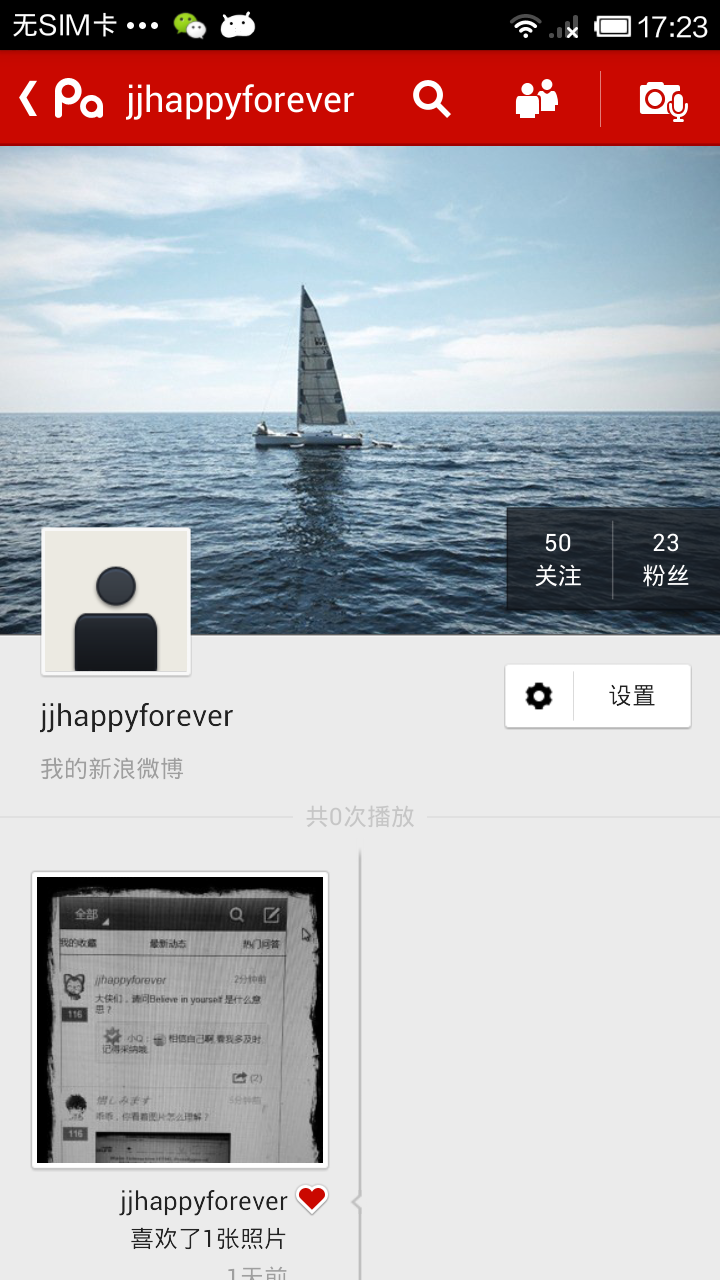
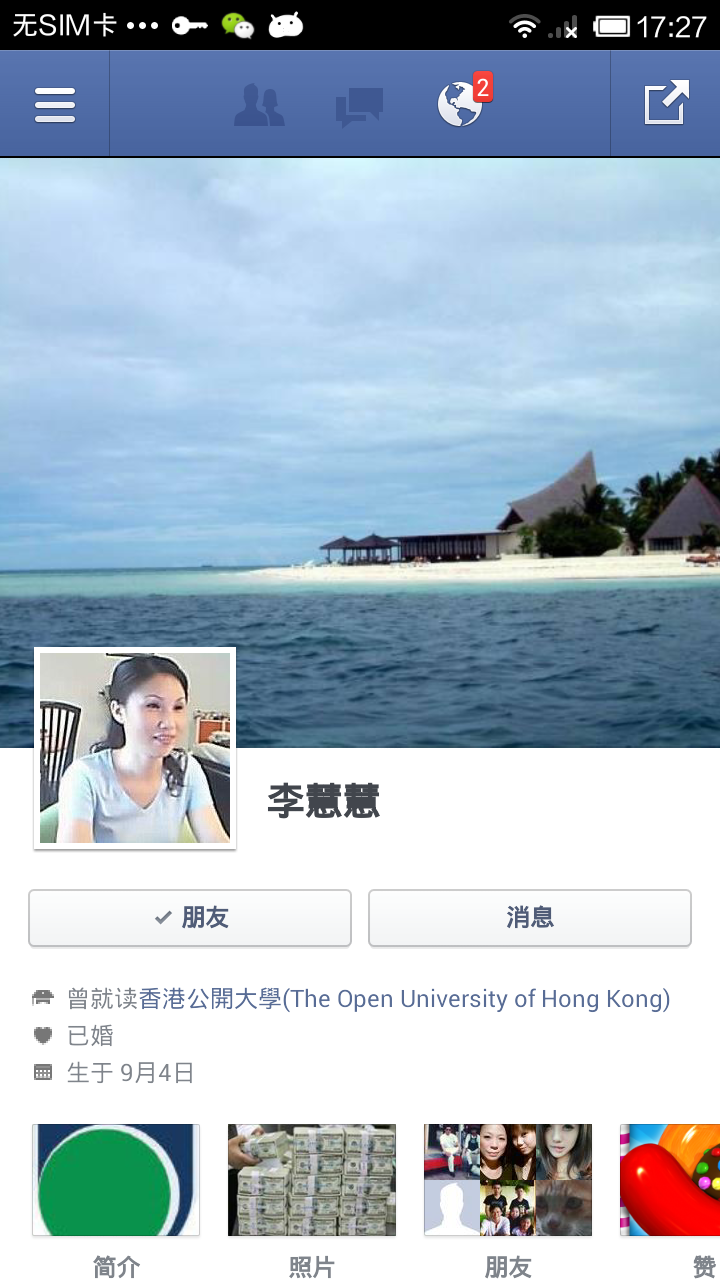
嘿嘿,不好意思,跑题了,针对上面出现的问题,我简单说明一下.
首先,比如我们手势下拉了50像素,其实是使得自定义ScrollView的孩子也就是LinearLayout这个控件的top为50,而这个时候的getScrollY()的值仍为0,但是如果此时你停止下拉反而向上拉取的话,那么此时的getScrollY()会从0开始逐步增大,当我们挪动到顶部也就是将ScrollView挪动到最底部,此时的isMoveing为true,所以你继承上拉的话会出现反弹效果。
这个问题要如何解决呢,其实也不难,但是我纠结了好长时光,也走了很多多少弯路。在这里说明一下我的瞎跑路段以及疑难:当时我就想,getScrollY()这么不听话,我何必非要对ScrollView的孩子进行操作呢,为何直接不对本控件执行layout(l,t,r,b)呢,后来就照着这个逻辑进行update,终于更改了差不多了,纠结了问题再次出现,在你下拉的时候对ScrollView本身执行layout(l,t,r,b)这个方法可以实现反弹效果,但是此时你确无法进行滑动了,就是ScrollView本身的滑动无缘无故的被禁止掉了.我怀疑是layout的时候参数弄错了。,后来仔细修改了下发明还是弗成以滑动,然后google了半天也杳无音讯,最后固然放弃,又回到了原点。接着揣摩。。。算是功夫不负有心人吧,最终想到了解决方案,希望对您有帮助。
还拿上面说到的那短话,比如我们手势下拉了50像素,那么此时touch的距离也就是50像素,如果此时我们反向上拉的话,同样是须要50像素回到最初的位置。说到这里我想大家都明确了。(首先我们要将操作离开,分为UP,DOWN,如果是DOWN的话,那么在下拉后执行上拉的时候我们禁用掉自定义控件的滑动,而是通过手势执行layout执行这50像素.)
上面我们看部分代码:
复制代码 代码如下:
/**对于初次Touch操作要判断方位:UP OR DOWN**/
if (deltaY < 0 && state == state.NOMAL) {
state = State.UP;
} else if (deltaY > 0 && state == state.NOMAL) {
state = State.DOWN;
}
if (state == State.UP) {
deltaY = deltaY < 0 ? deltaY : 0;
isMoveing = false;
shutTouch = false;
} else if (state == state.DOWN) {
if (getScrollY() <= deltaY) {
shutTouch = true;
isMoveing = true;
}
deltaY = deltaY < 0 ? 0 : deltaY;
}
代码很简单,不过多解释了,不明确的话,仔细看下源码确定就明确了。
touch 事件处理:
复制代码 代码如下:
/** touch 事件处理 **/
@Override
public boolean onTouchEvent(MotionEvent ev) {
if (inner != null) {
commOnTouchEvent(ev);
}
// ture:禁止控件本身的滑动.
if (shutTouch)
return true;
else
return super.onTouchEvent(ev);
}
说明:如果返回值为true,作用:禁止ScrollView的滑动,此时的Touch事件还存哦!!!如果对Touch事件比拟熟悉的同窗,相信以为我有点空话了,哈哈,我也是个小菜鸟,也卡在这里过。
最后呢,还有个小BUG,也就是那个顶部拉线,如果你让ScrollView惯性滑动的话,那么你会发明,顶部线条没有追随挪动,其实就是因为惯性滑动的时候我们是获得不到getScrollY()的值得造成的,查了半天也没有找到相关资料,这个问题就临时就留在这里,有时光了在续。
这里我将源码贴出来:
复制代码 代码如下:
package com.example.scrollviewdemo;
import android.content.Context;
import android.graphics.Rect;
import android.util.AttributeSet;
import android.util.Log;
import android.view.MotionEvent;
import android.view.View;
import android.view.animation.TranslateAnimation;
import android.widget.ImageView;
import android.widget.ScrollView;
/**
* 自定义ScrollView
*
* @author jia
*
*/
public class PersonalScrollView extends ScrollView {
private final String TAG = PersonalScrollView.class.getSimpleName();
private View inner;// 孩子View
private float touchY;// 点击时Y坐标
private float deltaY;// Y轴滑动的距离
private float initTouchY;// 初次点击的Y坐标
private boolean shutTouch = false;// 是不是关闭ScrollView的滑动.
private Rect normal = new Rect();// 矩形(这里只是个形式,只是用于判断是不是须要动画.)
private boolean isMoveing = false;// 是不是开始挪动.
private ImageView imageView;// 背景图控件.
private View line_up;// 上线
private int line_up_top;// 上线的top
private int line_up_bottom;// 上线的bottom
private int initTop, initBottom;// 初始高度
private int current_Top, current_Bottom;// 拖动时时高度。
private int lineUp_current_Top, lineUp_current_Bottom;// 上线
private onTurnListener turnListener;
private ImageView imageHeader;
public void setImageHeader(ImageView imageHeader) {
this.imageHeader = imageHeader;
}
// 状态:上部,下部,默认
private enum State {
UP, DOWN, NOMAL
};
// 默认状态
private State state = State.NOMAL;
public void setTurnListener(onTurnListener turnListener) {
this.turnListener = turnListener;
}
public void setLine_up(View line_up) {
this.line_up = line_up;
}
// 注入背景图
public void setImageView(ImageView imageView) {
this.imageView = imageView;
}
/***
* 构造方法
*
* @param context
* @param attrs
*/
public PersonalScrollView(Context context, AttributeSet attrs) {
super(context, attrs);
}
/***
* 根据 XML 生成视图工作实现.该函数在生成视图的最后调用,在所有子视图添加完以后. 即使子类覆盖了 onFinishInflate
* 方法,也应当调用父类的方法,使该方法得以执行.
*/
@Override
protected void onFinishInflate() {
if (getChildCount() > 0) {
inner = getChildAt(0);
}
}
/** touch 事件处理 **/
@Override
public boolean onTouchEvent(MotionEvent ev) {
if (inner != null) {
commOnTouchEvent(ev);
}
// ture:禁止控件本身的滑动.
if (shutTouch)
return true;
else
return super.onTouchEvent(ev);
}
/***
* 触摸事件
*
* @param ev
*/
public void commOnTouchEvent(MotionEvent ev) {
int action = ev.getAction();
switch (action) {
case MotionEvent.ACTION_DOWN:
initTouchY = ev.getY();
current_Top = initTop = imageView.getTop();
current_Bottom = initBottom = imageView.getBottom();
if (line_up_top == 0) {
lineUp_current_Top = line_up_top = line_up.getTop();
lineUp_current_Bottom = line_up_bottom = line_up.getBottom();
}
break;
case MotionEvent.ACTION_UP:
/** 回缩动画 **/
if (isNeedAnimation()) {
animation();
}
if (getScrollY() == 0) {
state = State.NOMAL;
}
isMoveing = false;
touchY = 0;
shutTouch = false;
break;
/***
* 消除出第一次挪动计算,因为第一次无法得知deltaY的高度, 然而我们也要进行初始化,就是第一次挪动的时候让滑动距离归0.
* 以后记载精确了就正常执行.
*/
case MotionEvent.ACTION_MOVE:
touchY = ev.getY();
deltaY = touchY - initTouchY;// 滑动距离
/** 对于初次Touch操作要判断方位:UP OR DOWN **/
if (deltaY < 0 && state == state.NOMAL) {
state = State.UP;
} else if (deltaY > 0 && state == state.NOMAL) {
state = State.DOWN;
}
if (state == State.UP) {
deltaY = deltaY < 0 ? deltaY : 0;
isMoveing = false;
shutTouch = false;
/** line_up **/
lineUp_current_Top = (int) (line_up_top - getScrollY());
lineUp_current_Bottom = (int) (line_up_bottom - getScrollY());
Log.e(TAG, "top=" + getScrollY());
line_up.layout(line_up.getLeft(), lineUp_current_Top,
line_up.getRight(), lineUp_current_Bottom);
} else if (state == state.DOWN) {
if (getScrollY() <= deltaY) {
shutTouch = true;
isMoveing = true;
}
deltaY = deltaY < 0 ? 0 : deltaY;
}
if (isMoveing) {
// 初始化头部矩形
if (normal.isEmpty()) {
// 保存正常的布局位置
normal.set(inner.getLeft(), inner.getTop(),
inner.getRight(), inner.getBottom());
}
// 挪动布局(手势挪动的1/3)
float inner_move_H = deltaY / 5;
inner.layout(normal.left, (int) (normal.top + inner_move_H),
normal.right, (int) (normal.bottom + inner_move_H));
/** image_bg **/
float image_move_H = deltaY / 10;
current_Top = (int) (initTop + image_move_H);
current_Bottom = (int) (initBottom + image_move_H);
imageView.layout(imageView.getLeft(), current_Top,
imageView.getRight(), current_Bottom);
/** line_up **/
lineUp_current_Top = (int) (line_up_top + inner_move_H);
lineUp_current_Bottom = (int) (line_up_bottom + inner_move_H);
line_up.layout(line_up.getLeft(), lineUp_current_Top,
line_up.getRight(), lineUp_current_Bottom);
}
break;
default:
break;
}
}
/***
* 回缩动画
*/
public void animation() {
TranslateAnimation image_Anim = new TranslateAnimation(0, 0,
Math.abs(initTop - current_Top), 0);
image_Anim.setDuration(200);
imageView.startAnimation(image_Anim);
imageView.layout(imageView.getLeft(), (int) initTop,
imageView.getRight(), (int) initBottom);
// 开启挪动动画
TranslateAnimation inner_Anim = new TranslateAnimation(0, 0,
inner.getTop(), normal.top);
inner_Anim.setDuration(200);
inner.startAnimation(inner_Anim);
inner.layout(normal.left, normal.top, normal.right, normal.bottom);
/** line_up **/
TranslateAnimation line_up_Anim = new TranslateAnimation(0, 0,
Math.abs(line_up_top - lineUp_current_Top), 0);
line_up_Anim.setDuration(200);
line_up.startAnimation(line_up_Anim);
line_up.layout(line_up.getLeft(), line_up_top, line_up.getRight(),
line_up_bottom);
normal.setEmpty();
/** 动画执行 **/
if (current_Top > initTop + 50 && turnListener != null)
turnListener.onTurn();
}
/** 是不是须要开启动画 **/
public boolean isNeedAnimation() {
return !normal.isEmpty();
}
/***
* 执行翻转
*
* @author jia
*
*/
public interface onTurnListener {
/** 必须到达必定水平才执行 **/
void onTurn();
}
}
效果图:
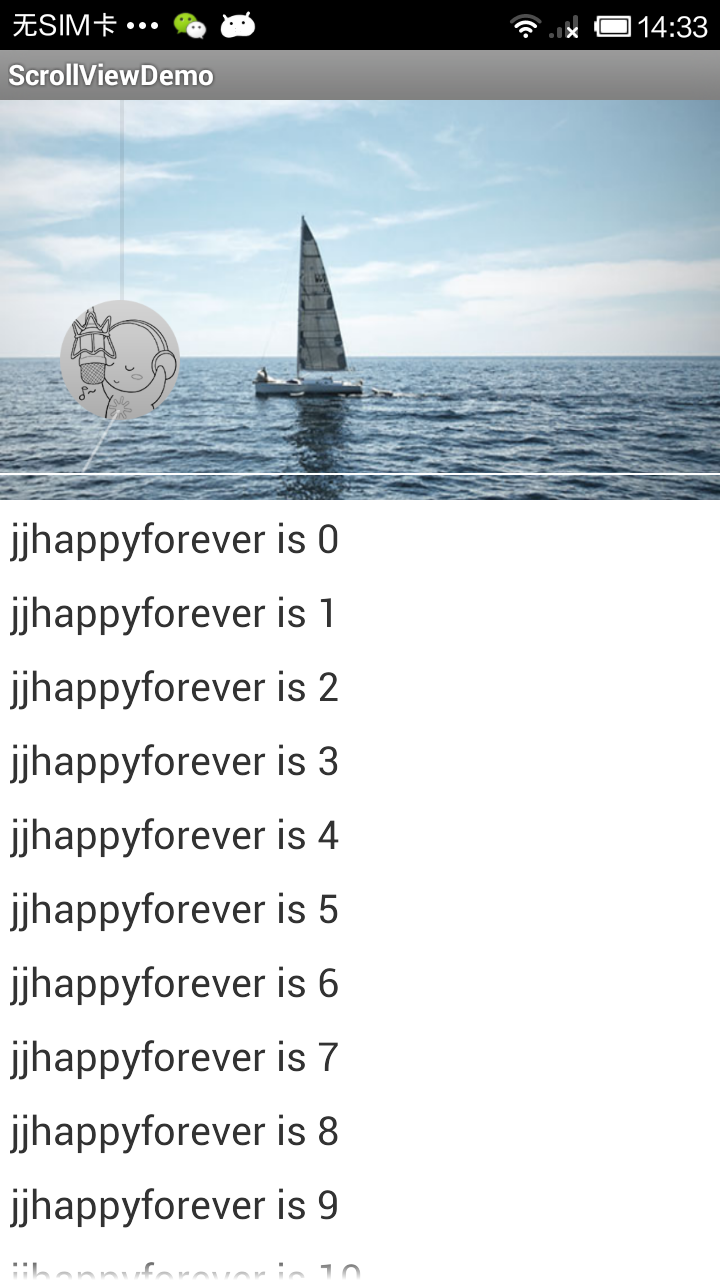
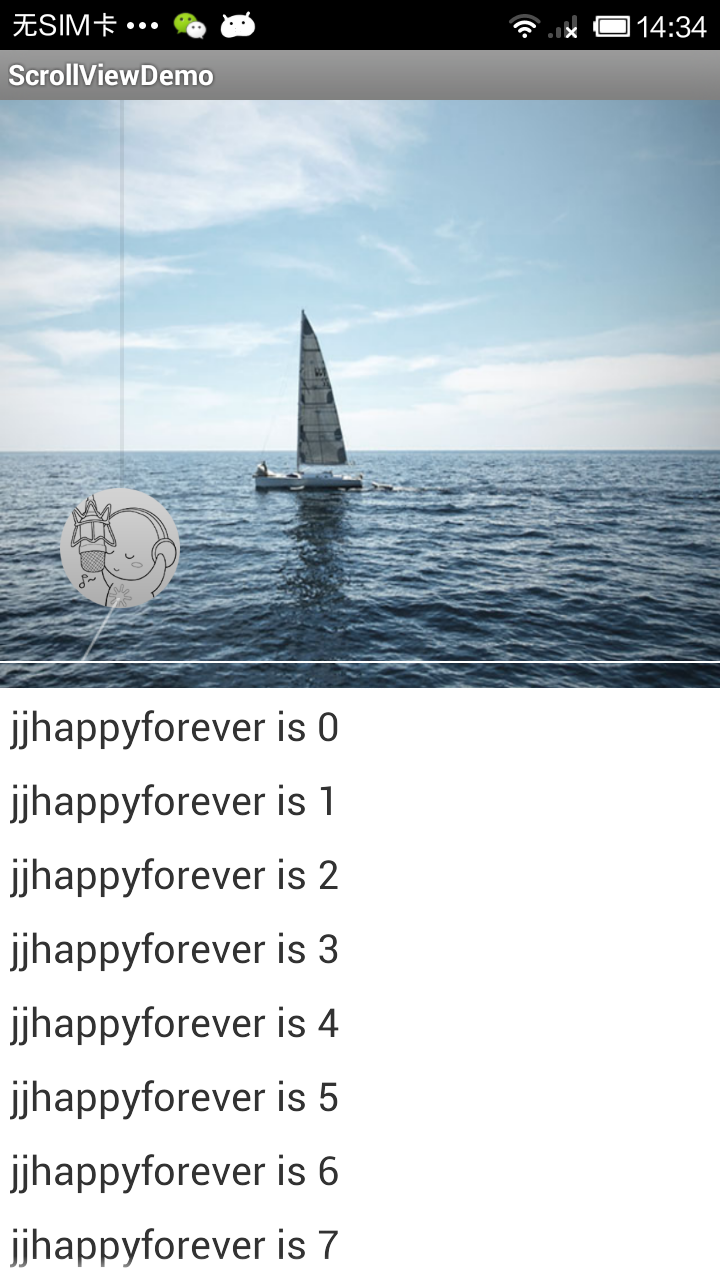
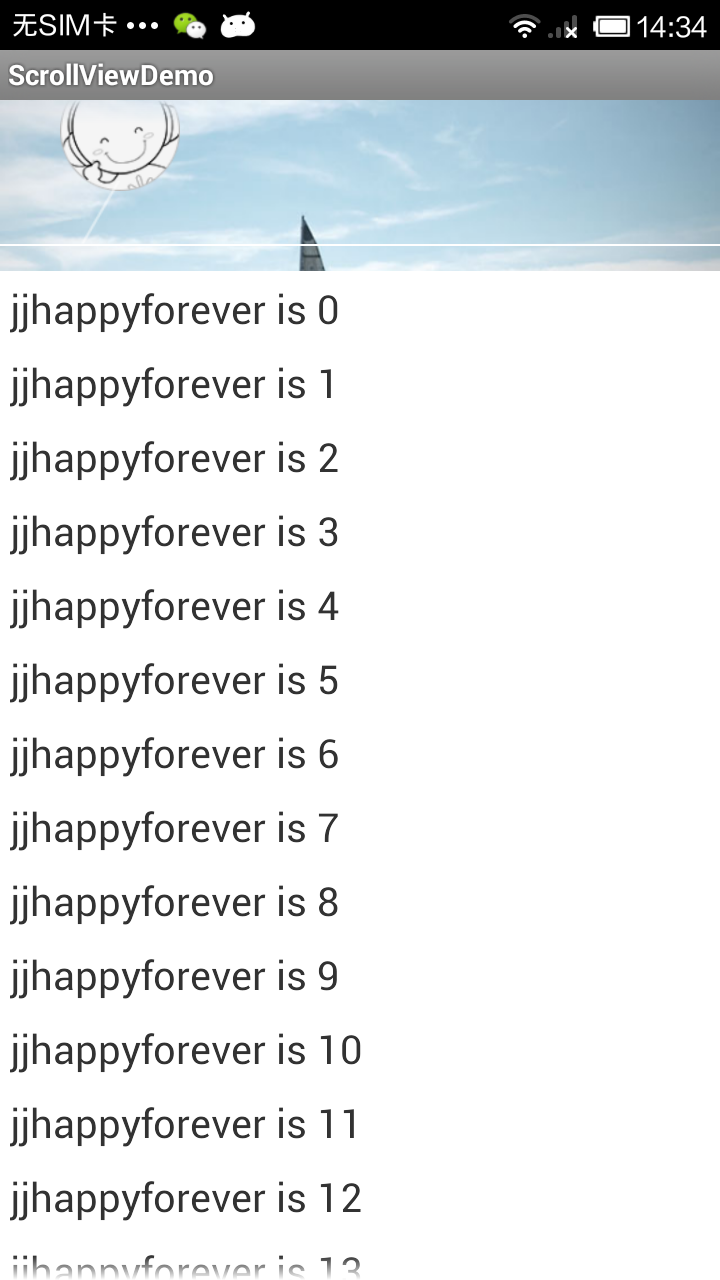
界面有点丑陋,不过UI可以自己根据需求进行调整.
- pp列表之分组ListView详解
- 双缓冲技术实现Android 画板应用
- Android入门之画图详解
- Android 广播大全 Intent Action 事件详解
- 九宫图比较常用的多控件布局(GridView)使用
- android调试工具DDMS的使用详解
- Android控件之SlidingDrawer(滑动式抽屉)详